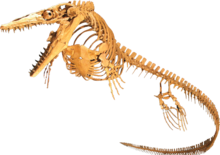Mosasauria
extinct superfamily of Anguimorpha
Mosasauria of Mosasaurs (from Latin Mosa 'the Meuse', and Greek σαύρος (sauros) 'lizard') comprise a group of extinct, large marine reptiles from the Late Cretaceous. Their first fossil remains were discovered in a limestone quarry at Maastricht on the Meuse in 1764. They belong to the order Squamata, which includes lizards and snakes.


Quotes
edit- Kansas, par excellence, has been the great collecting ground of the world for these reptiles.
- Samuel W. Williston, The University Geological Survey of Kansas, Vol. IV, Part 1 (1898), p. 83
- The typical mosasaur was shaped like a moray or salt-water eel, with the addition of four broad paddles, built for steering rather than for rowing.
- L. Sprague de Camp & Catherine Crook de Camp, The Day of the Dinosaur (1968), p. 159
- Some mosasaurs may have been a belated ecological replacement of Triassic ichthyosaurs, but not of the Late Cretaceous thunniform ichthyosaurs. Triassic ichthyosaurs were ambush predators, and gave rise to pursuit predators at the beginning of the Jurassic, all long before mosasaurs. The vacated Triassic ichthyosaur ecological niche was partially filled by marine crocodiles and much later by aigialosaurs. Then mosasaurs came along and did the job of ambush predation better than the others put together and some may have filled a similar ecological niche to that of Triassic ichthyosaurs.
- Letter from Lingham-Soliar to Richard Ellis, quoted in Sea Dragons (2003), p. 200
- Ichthyosaurs and plesiosaurs had a much longer history than mosasaurs and appear to have been scaleless. It is possible that a smooth skin was much better adapted for a life in the ocean than was one with scales because it offered less resistance in the water, or because it provided fewer opportunities for the attachment of parasites. Mosasaurs, on the other hand, were covered with small scales, the shape and arrangement of which resembled those of modern monitor lizards.
- Michael J. Everhart, Oceans of Kansas (Indiana University Press, 2005), p. 178